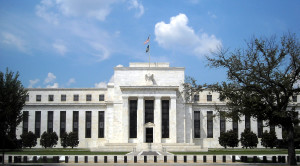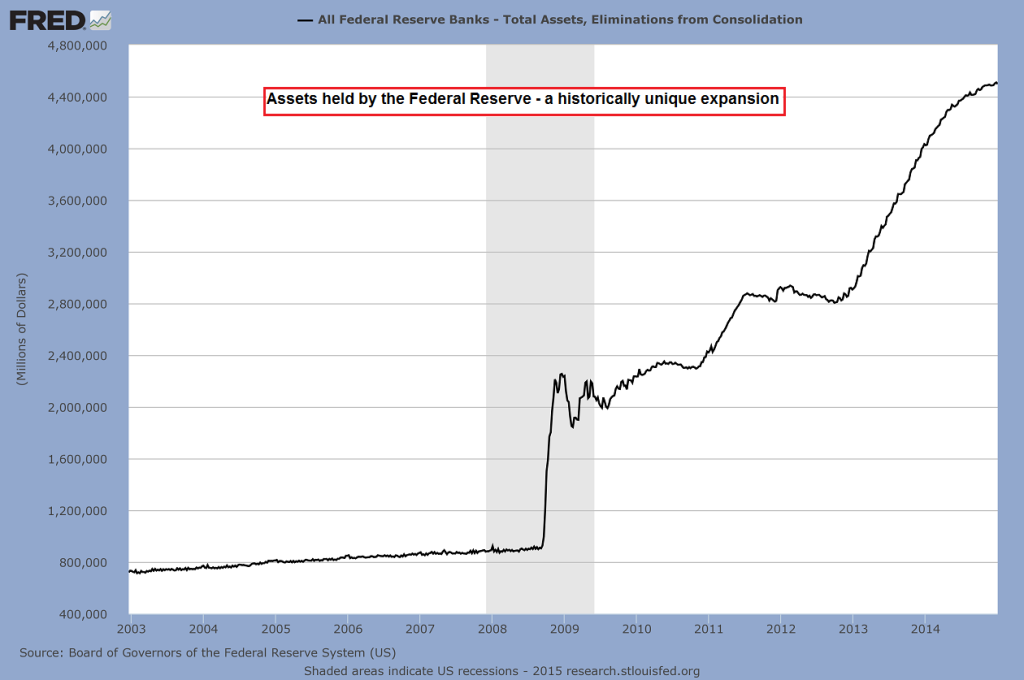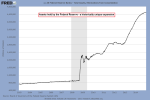by Bill Bonner – Bonner and Partners.com:
On Friday, the Labor Department released a shockingly weak March jobs report. The feds and their cronies on Wall Street spent the weekend trying to put a bag over its head.
Former Pimco CEO and Bloomberg columnist Mohamed El-Erian gave this quick reaction:
The US employment machine notably lost momentum in March, with just 126,000 new jobs added – far fewer than the consensus expectation of around 250,000 – and with revisions erasing 69,000 from the previous two months’ total, according to the Labor Department. The lackluster result ends an impressive 12-month run of job gains in excess of 200,000.
Yes, the employment numbers were ugly. They confirm the other evidence coming in from hill and dale, industry and commerce, households and homesteads all across the nation, and all the ships at sea: This is no ordinary recovery.
Nip and Tuck
In fact, it’s no recovery at all. It is strange and unnatural, like the victim of a quack plastic surgeon.
But the damage was not an accident. No slip of the hand or equipment malfunction produced this horror. It was the result of economic grifters plying a fraudulent trade.
The Dow rose 118 points in Monday’s trading. A 0.7% increase, this was neither the result of honest investing nor any serious assessment of the economic future. Bloomberg attributed it to scammery from the Fed:
New York Fed President William Dudley said the pace of rate increases is likely to be “shallow” once the Fed starts to tighten.
His comments were the first from the inner core of the Fed’s leadership since a government report showed payrolls expanded less than forecast in March.
While data signaling rates near zero for longer have previously been welcomed by American equity investors, concern is building that economic weakness will worsen the outlook for corporate profits.
Get it?
“Shallow” rate increases. Translation: Savers will get nothing for their forbearance and discipline for a long, long time.
Instead, the money that should be rightfully theirs will be transferred to the rich… and to gamblers and speculators… as it has for the last six years.
A Frankenstein Economy
Back to El-Erian who, having seen the evidence of this botched operation, then goes goofy on us. He calls upon the authorities to “do something.”
As if they hadn’t done enough already!
The feds were the ones who injected the credit silicon, hardened the upper lip and created the Monster of 2008.
And then, when the nearest of kin started retching into the hospital wastebaskets, they went back to work. Now, the economy is more grotesque than ever.
But here’s El-Erian, asking for more:
The report is a further reminder of how much more the US economy could – and should – achieve if it weren’t for political dysfunction in Washington and a “do little” Congress that preclude more comprehensive structural reforms, infrastructure spending and a more responsive fiscal policy.
El-Erian is not the only one. One of our favorite knife men, Larry Summers, is suggesting more nip and tuck on the whole world economy.
It was Summers, as secretary of the Treasury between 1999 and 2001, who helped stitch this Frankenstein economy together.
He and his fellow surgeons are responsible for its unsightly lumps and inhuman shape. Their trillions of dollars of EZ credit leaked all over, causing bulges almost everywhere.
Does China have too much industrial capacity? Does the world have a glut of energy? Are governments far too deep in debt? And corporations?And households? Didn’t nearly every central bank in the world try to stimulate demand with cheap credit… thus laying on a burden of debt so heavy that it now threatens the entire world economy?
Poor Larry Summers
Now, Summers waves his scalpel in the air and can’t wait to get the patient back on the table.
He worries that the US should have given the International Monetary Fund more money, which would have “bolstered confidence in the global economy.”
He thinks the world’s problem is that “capital is abundant, deflationary pressures are substantial, and demand could be in short supply for quite some time.”
Poor Larry can’t tell the difference between capital and credit.
Capital – what you get from saving money and investing it wisely – is an economy’s real muscle. EZ credit – what the quacks pump into flabby tissue to try to make things look more fetching – is what has turned the economy into such a freak.
Alas, failing to give more money to the IMF, says Summers, may mean “the US will not be in a position to shape the global economic system.”
That would be a real pity.
Article originally posted at
Posted on Categories Finance & EconomicsLeave a comment on The Scary Truth Behind Friday’s Jobs Shocker
submitted by jwithrow. Excerpt from The Folly of the Fed’s Central Planning: 1. Increasing money and credit by the Fed is not the same as increasing wealth. It in fact does the opposite. 2. More government spending is not equivalent to increasing wealth. 3. Liquidation of debt and correction in wages, salaries, and consumer prices is not the monster that many fear. 4. Corrections, allowed to run their course, are beneficial and should not be prolonged by bailouts with massive monetary inflation. 5. The people spending their own money is far superior to the government spending it for them. 6. Propping up stock and bond prices, the current Fed goal, is not a road to economic recovery. 7. Though bailouts help the insiders and the elite 1%, they hinder the economic recovery. 8. Production and savings should be the source of capital needed for economic growth. 9. Monetary expansion can never substitute for savings but guarantees mal–investment. 10. Market rates of interest are required to provide for the economic calculation necessary for growth and reversing an economic downturn. 11. Wars provide no solution to a recession/depression. Wars only make a country poorer while war profiteers benefit. 12. Bits of paper with ink on them or computer entries are not money – gold is. 13. Higher consumer prices per se have nothing to do with a healthy economy. 14. Lower consumer prices should be expected in a healthy economy as we experienced with computers, TVs, and cell phones. All this effort by thousands of planners in the Federal Reserve, Congress, and the bureaucracy to achieve a stable financial system and healthy economic growth has failed. It must be the case that it has all been misdirected. And just maybe a free market and a limited government philosophy are the answers for sorting it all out without the economic planners setting interest and CPI rate increases. A simpler solution to achieving a healthy economy would be to concentrate on providing a “SOUND DOLLAR” as the Founders of the country suggested. A gold dollar will always outperform a paper dollar in duration and economic performance while holding government growth in check. This is the only monetary system that protects liberty while enhancing the opportunity for peace and prosperity. submitted by jwithrow. Journal of a Wayward Philosopher January 15, 2015 The S&P opened at $2,013 today. Gold is up to $1,262 per ounce. Oil rallied back up to $48 per barrel. Bitcoin has dived to $216 per BTC, and the 10-year Treasury rate opened at 1.81% today. The big news in the markets today comes from the Swiss National Bank which announced that they will abandon the Franc’s peg to the Euro. This move suggests the SNB is expecting Europe to ramp up its very own quantitative easing program in a big way. If that happens we can expect the U.S. dollar to strengthen, Treasury rates to continue their decline, and gold to rise in price. Such a move could also spark another bull cycle for gold miners in the equity markets. We shall see. If you ask the media, they will tell you the economy is recovering quite nicely. They will tell you they are a little disappointed the recovery has taken this long, but a recovery it is nonetheless. And sure enough, the economic landscape does look better now than it did in 2009. If you live in a metropolitan area you may even be tempted to think the media is absolutely correct – happy days are here again! The stock market has boomed, mortgage rates are on the floor, and the banks are lending once again… what more could anyone ask for? Regretfully, I must point out that whatever recovery has taken place is due exclusively to a credit expansion of historic measures. Take a look at this chart from the Fed’s Board of Governors. The Federal Reserve’s balance sheet expanded from $890 billion ($890,000,000,000) to $4.5 trillion ($4,500,000,000,000) in just six years. This balance sheet expansion represents the acquisition of assets by the Federal Reserve – U.S. Treasury Bonds and mortgage-backed securities specifically. What this means is the Fed purchased bonds from the federal government to finance government deficits and the Fed purchased mortgage-backed securities from Wall Street to bail out the banks. The Fed saved the day! But we must ask – where did the Fed get the dollars to save the financial system? Well if you are familiar with our work on fiat money then you know the Fed created those dollars out of thin air. That’s 3.61 trillion ($3,610,000,000,000) extra dollars floating around in the financial system conjured into existence. Is it any wonder interest rates hit the floor and stocks boomed? Go back and ask the media and they will tell you this is normal. The Fed did what it was supposed to do, they will say, it exists to manage the financial system. The media has had six and half years to feel confident in this assessment. But the Fed itself shows us what the problem is – the recovery is unsustainable! Let’s go back and look at the chart. The Fed has classified the period from the end of 2007 to the middle of 2009 as a recession. The Fed shows how it printed $1.41 trillion during that time period and brought an end to the recession. But then the Fed kept on printing – in even greater quantities! If the recession ended in 2009, why did the Fed need to create another $2.2 trillion over the next five years? The answer is clear as day and the Fed shows us why – the recovery is solely dependent upon exponential credit expansion. It’s game over as soon as the credit stops expanding. The fact is no structural reforms have taken place within the financial system since the crash of 2008. All of the underlying problems are still present; they have simply been papered over by credit creation of historic proportions. As much as the media would have you believe otherwise, you just can’t cure a debt problem with more debt. ”Sooner or later everyone sits down to a banquet of consequences.” said Robert Louis Stevenson. For those living outside of the major U.S. metropolitan areas, that banquet of consequences is here. Middle America has been hollowed out and small town U.S.A. has been destroyed by the fiat monetary system that has been employed since 1971. Income inequality has risen rapidly, not because of greedy capitalists, but because politically-connected institutions have been the recipients of enormous quantities of money and credit created from nothing. What is occurring is a wealth transfer of epic proportions. It is the middle class that bears the brunt of this massive wealth transfer. As we mentioned in our first journal entry of 2015, the Cantillon Effect is in full swing. The individuals and businesses farthest away from the printing press have their wealth systematically transferred away from them to the institutions with their cup under the money spigot. Don’t believe me? Take a trip to K-Street and observe what goes on there. Of course there’s nothing new under the sun. This dynamic has played out numerous times in various places throughout modern history. It always leads to the destruction of the middle class and then the destruction of the monetary system itself. Fortunately, individuals can insulate themselves from some of the financial destruction if they understand what is happening. It is understanding that is the most difficult part. Until the morrow, Joe Withrow For more of Joe’s thoughts on the “Great Reset” and the fiat monetary system please read “The Individual is Rising” which is available at http://www.theindividualisrising.com/. The book is also available on Amazon in both paperback and Kindle editions. submitted by jwithrow. Debt is nothing more than an obligation to pay for present spending with future earnings. A little bit of debt used to increase future earnings is a good thing. A little bit of debt used to increase present spending at the expense of future earnings is not a very good thing. A lot of debt used to increase present spending at the expense of future earnings is a good way to make it very difficult for there to be any earnings in the future at all. At the macroeconomic level, the U.S. has chosen option three. Japan and Europe have done the same. The great thing about economics is that there is a ‘response’ system built in that maintains a sort of chaotic order in the general market. When there is significant capital formation within the system, interest rates go down. Decreasing interest rates send a signal that it is a good time to borrow so homes are purchased and businesses expand. Interest rates then rise as more debt is taken on and thus capital available diminishes. This sends a signal that it is not a good time to borrow so mortgages are paid down and business debt is reduced. This leads to gradual capital formation within the system that will trigger a decrease in interest rates and the cycle perpetuates. But guess what happens when you have an Ivy League graduate that thinks it is his job to force interest rates lower and keep them suppressed? That’s right! The market does not receive the proper signal and it looks like it is still a good time to borrow. So even more homes are purchased and businesses keep on expanding. Then we get the idea that home prices should always go up, stock prices should always go up, businesses should always expand, and GDP should always grow. And we end up with more debt. U.S. debt has grown by more than 60% since the financial crisis began in 2008. Global debt has grown by more than 40% in the same time period. It turns out that a problem of too much debt cannot be solved by taking on more debt. The events of 2008 sent a signal that it was time to stop borrowing and to liquidate debt but we didn’t listen. The economy will undoubtedly blow up again and the next crisis will be even bigger because the debt is now even bigger. The only way for the economy to truly recover is for a mass-liquidation of debt to occur. Until then we can expect the Fed to keep fudging the numbers and blaming economic stagnancy on the snow. We happen to like snow and find it to be much more desirable than the Fed, both economically and ascetically.Fourteen Lessons for the Federal Reserve

How the Fed Destroys the Middle Class

How the Fed Destroys the Middle Class
Hot Springs, VA
Wayward PhilosopherDebt Impedes Economic Recovery





